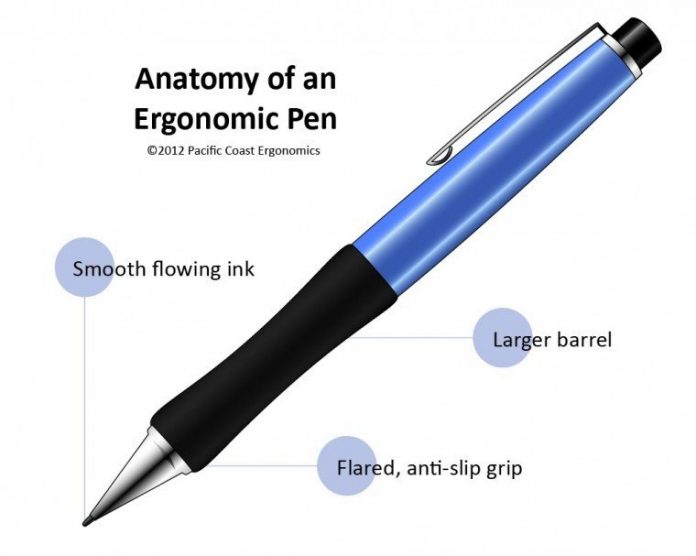Writing may not seem like a strenuous activity, but it can hurt! Gripping a small implement places potentially painful pressures on the tiny muscles of the hands and fingers. Writing frequently or for long durations escalates the risk of pain.
An ergonomic pen is designed to reduce the forces of writing. Compared to a regular pen, the ergonomic pen’s barrel is larger in diameter and easier for the average sized adult hand to hold.
In addition, a cushioned, anti-slip material helps keep your fingers in place. Some ergonomic pens also flare out toward the bottom to further prevent your fingers from sliding. Smoothly flowing ink cuts down on forces associated with writing.
You may not think that your fingers slide down a pen when you’re writing and you’re probably right. But the thing that prevents sliding on the smooth, narrow cylinder of a typical pen is the extra force exerted by your fingers pinching the barrel. This places a burden on those vulnerable hand muscles as well as putting pressure on the thumb joints, which can prove painful over time.
You should strongly consider using an ergonomic pen (or pencil) if either of the following is true:
– You feel pain or strain in your writing hand, especially in your thumb or on the side of your wrist near the thumb.
– You spend a lot of time writing, particularly if you write through multiple copies.
Pens for petite and large hands:
– If your hands are smaller than average, consider one of the many non-refillable ergonomic pens that have a slightly larger barrel and a cushioned, anti-slip grip. These are often sold in packages of two or more.
– If your hands are very large, look for an extra-large ergonomic pen such as the Bic XXL Pen. These are also usually non-refillable, and are available at most office supplies stores and some general purpose pharmacies.
Take good care of your hands – you need them!
Nancy M. Lowe is the owner of Pacific Coast Ergonomics, a local ergonomics consulting firm. As a Certified Ergonomist, Registered Physical Therapist and Certified Hand Therapist, she has been treating and preventing injuries for over 20 years.













